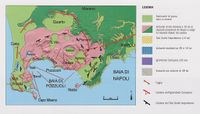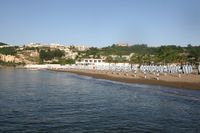Case Study C: Averno
>>>back to working groups overview
Rationale
- Why do you think this case is relevant? What is your hypothesis considering the landscape challenges?
- Format: 3-4 sentences
Location and scope
A Landscape System Analysis
A.1 Landscape layers and their system context
Geomorphology, landscape units and coastal typology
The formation of Italy as we know is the result of a series of complex sismic movements, starting from the collision between the African and European tectonic plaques. The sequence of collisions created the long chain of montains that crosses the country from south to north, the Alpenines. Smaller geografical accidents happened due to the phenomena, which, combined with the volcanic activities, led to the nowadays morphology.
In Pozzuoli, it is not different: lakes, shores and reefs tell us the evolution of the landscape. Today, both sismic and volcanic activities remain quiet, but not long ago, in the 1980's, Pozzuoli had to move around 50m ahead from its original location due to a rapid rising of the earth surface. Combined with the stress caused by populational growth, the town could a major change on its landscapes
Geomorphology Pozzuoli. Source: http://ncpcstasia.weebly.com/il-rischio-vulcanico.html
Coastal volcanic rocks. Source: https://www.repubblica.it/viaggi/2015/12/04/news/scoprire_campi_flegrei_napoli_campania-128801959/
Low coast with volcanic rocks on the background. Source: https://lidonapoli.it
Land use
- settlements, infrastructure, agriculture, resource extraction, natural areas, energy production...
- description of evolution, status quo and driving forces, is the land use likely to change? Why is that? (approx 200 signs)
- add 1-2 graphical representations to the image gallery, you can add more if you like
- Yourcase landuse1.jpg
add a caption
- Yourcase landscapeunits2.jpg
add a caption
- Yourcase landscapeunit3.jpg
add a caption
Green/blue infrastructure
- What are the major potential elements of a green/blue infrastructure network? Are these likely to change/disappear? Why is that?
- You find my background material on green infrastructure in our reading list
- add 1-2 graphical representations to the image gallery, you can add more if you like
- Your case green blue infrastructure1.jpg
add a caption
- Your case green blue infrastructure2.jpg
add a caption
Actors and stakeholders
- Who is driving changes in this landscape? Who is affected by those changes?
- Draw a stakeholder and/or power map: Who is affected highly but with low power? Who has high power but is not affected?
- Your case your powermap.jpg
add a caption
Sacred spaces and heritage
The study area consists of two very important landmarks: Apollo’s Temple and Terme Stufe di Nerone and also really important natural heritage elements: Lake Averno, Lake Lucrino, the Regional Park of Campi Flegrei and Monte Nuovo. The landmarks are close to the Lake Averno and Lake Lucrino and the natural heritage makes up about 40% of the study area.
The Thermae, usually called “Temple of Apollo” is found on the Eastern shore of Lake Averno and consists of two levels enriched by niches and windows, the plan is octagonal outside and circular shaped on the inside. The thermal baths at Terme Stufe di Nerone are positioned on the southern side of Lucrino Lake. The therapeutic benefits of thermal waters and the wonderful natural surroundings made the Terme Stufe di Nerone be very appealing to the citizens of ancient Rome. These thermal baths kept on improving over the years, becoming bigger up to the size that can be seen today. Lake Averno is a roughly circular lake, measuring up to 2km in circumference and 60m in depth. This lake was of immense importance to the Romance since they believed to be the entrance to Hades. The lake used to be owned by the House of Bourbon, then by an aristocratic family who then sold it to Cardillo family. Finally the lake was seized by law enforcement in 2010. Lake Lucrino is found one km south of Lake Averno and is separated from the sea by a slim strip of land. The Lake used to be bigger but due to the cratered volcanic cone of Monte Nuovo it became smaller sincer 1538. The Campi Flegrei Regional Park represents one of the most important parts of the region being a part of an intergrated landscape-cultural-environmental territorial system. The territory is characterized by the diverse landscape: coast, volcanic activity, thermal waters, natural ports and protected areas. Monte Nuovo is a volcanic cone that last erupted in 1528 due to damaging earthquakes and changes in land elevation. Its eruption is important because it was the first eruption described by a large number of witnesses.
- You may add a map and some images, please also explain in your caption why these elements are valuable
- Your case sacredspace1.jpg
add a caption
- Your case sacredspace2.jpg
add a caption
- Your case sacredspace3.jpg
add a caption
Visual appearance and landscape narrative
- Which elements are essential for the landscape character?
- Has the landscape been painted or otherwise depicted, when and whom? Which elements are essential?
- Which narratives exist? Who has written about this landscape or depicted it in some way?
- You can add text and images
- Your case character1.jpg
add a caption
- Your case character2.jpg
add a caption
- Your case character3.jpg
add a caption
A.2 Summary of you landscape system analysis and your development Targets
- You can summarize your findings with an DPSI(R) Model or a Spider Diagram
- Link back to the Sustainable Development Goals: Which goals are at risk?
- What is your hypothesis for this landscape?
- Visualise your hypothesis with one graphic/pict
- Are there any existing initiatives taking action in this landscape? Do you have a critical perspective on that?
- Add text and visuals
- Your case your spider diagram or dpsir model.jpg
explain your analysis briefly in the caption
- Your case your hypothesis visual.jpg
explain your hypthesis briefly in the caption
A.3 Theory reflection
- Reflect on at least three international policy documents in relation to their local landscape case
- choose one international, one European and one national document
- You can choose references from our reading list
- Scope: 250 words
A.4 References
- give a full list of the references you have used for this section
Phase B: Landscape Evaluation and Assessment
B.1 Assessment Strategy
- Based on the hypothesis derived from your previous landscape systems analysis you are now asked to define the goals for assessing the landscape. Your assessment is the basis for evaluating the landscape status.
- Which elements and phenomena need to be mapped, why and how?
- This a text contribution, max 250 words
B.2 Mapping
- As defined by your assessment strategy you conduct the mapping and present your findings here
- As a minimum, at least three different themes need to be mapped, you may choose more if needed
- Your case your assessment mapping themel.jpg
briefly explain the findings of your mapping
- Your case your assessment mapping theme2.jpg
briefly explain the findings of your mapping
- Your case your assessment mapping theme3.jpg
briefly explain the findings of your mapping
B.3 Problem definition and priority setting
- Give a summary of the major findings of your mapping process, what are the problems/potentials identified?
- Draw a problems/potentials map
- Set priorities for the most relevant issues
- Your case problems potentials map.jpg
add caption here
B.4 Theory reflection
- Please reflect the assessment and evaluation methods used based on at least three readings
- Did you encounter limitations'
- 200 words test contribution
B.5 References
- give a full list of the references you have used for this section
Phase C – Strategy and Master Plan
C.1 Goal Setting
- Define strategic planning objectives based on the evaluation findings
- Link back to your original targets from section one and the Development Goals
- 150 words text contribution
C.2 Spatial Strategy and Transect
- translate your strategic goals into a vision
- develop a spatial translation of your vision
- exemplify your vision in the form of a transect with concrete interventions
- add map(s) and visualizations
- Your case spatial translaton vision.jpg
add caption here
- Your case transect.jpg
add caption here
- Your case transect detail1.jpg
add caption here
- Your case transect detail2.jpg
add caption here
C.3 From Theory of Change to Implementation
- For implementing your vision: Which partnerships are needed? Which governance model is required?
- Who needs to act and how? Draw and explain a change/process model/timeline
- Which resources are needed? On which assets can you build?
- add 150 words text and visuals
- Your case spatial your governance model.jpg
add caption here
- Your case spatial your process model.jpg
add caption here
C.4 References
- give a full list of the references you have used for this section
D. Process Reflection
- Reflect in your intercultural and interdisciplinary team on the outcomes of your study
- Which limitations were you facing?
- What have you learnt from each other?
- What would you do differently next time?
- You can also use diagrams/visuals
- 250 words text



